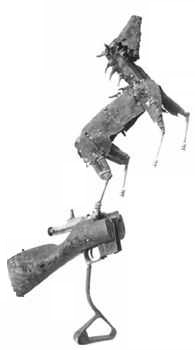
The Christian Council of Mozambique (CCM) is renowned for its creative response to the
proliferation of small arms in their region. The CCM's "Transforming Guns into Hoes" (TAE) project uses the words of Micah 4:3 as the basis for modern activism:
into ploughshares, and their spears into pruning hooks."
"The most memorable group came from Subutu with five hundred guns that they had discovered hidden in a dump. We gave this group a tractor in appreciation of their effort," said Anglican Bishop Dinis Sengulane, General Secretary of the CCM.
|
 Cavalo by Fiel dos Santos Marques Rafael |
|
Mozambique is a country of immense natural resources but impoverished by 17 years of civil war.
Though the war is officially over and has been for some time, violence has remained endemic. A peace treaty was signed in 1992 between the government and opposition forces, yet the country remains awash with the tools of war. As long as there is a surplus of arms, violence will continue to undermine efforts to build peace in a post-conflict period of reconstruction.
Some Mozambicans have guns so that they can sell them for as little as 6 US$ to buy food and other basic necessities. Guns are often sold across the border in South Africa, where increasing crime and ethnic violence have helped fuel the trade in arms. The average Mozambican lives on 800 US$ per year. In the face of such desperate poverty, crime is on the rise and therefore so too is the proliferation of guns. Still others, having been conditioned by years of civil war, hold onto their weapons. Being armed ensures "security". Stores of guns, hidden away by armed forces during the war, remain hidden and unclaimed. These stockpiles are uncovered by professional search teams and playing children alike. Equally as dangerous and prevalent are the landmines laid by both government and rebel forces during the civil war. Some mines were laid defensively. Others were used to destroy the infrastructure and contribute to general instability. Though the war has ended, the landmines are still there. Not only are they curtailing economic development, making potential farmland unsafe to walk on, they have caused over 10,000 injuries and deaths. The CCM was compelled to respond to this crisis. While some activists worried about creating too short-sighted and complicated a project, Bishop Sengulane insisted that "turning swords into ploughshares should be a top priority for churches". He called on churches to help young soldiers -- some drafted when still children -- to become productive members of society and supported the development of the "Transforming Guns into Hoes" programme. The CCM introduced the programme in 1991 during the peace process. However, due to delays beyond their control, it was not officially launched until October 1995. In the first five months of the programme an average of 115 weapons per month were handed in. By May 1998, 1,500 firearms and 34,000 explosives had been destroyed. How does the CCM dispose of the guns? Staff such as Jacinto Muth, programme director at the CCM, place the arms and ammunition in a pit, lace them with dynamite, then set off fuses. Destroying stockpiles of weapons is a dangerous process. There is always the potential that one of the volunteers stacking mortars in the pit might set off an explosion that could kill everyone. When all of the weapons are in place, the volunteers retreat to the safety of a lookout site about a mile away from where they watch the flash, hear a deafening roar then see a thick dark cloud rising in the distance. Recently the CCM has not only destroyed arms but has developed a project in which artists transform old guns and ammunition into sculpture. Animal and human figures are shaped out of the handles of AK-47s, defused grenades, ammunition shells and bullets. The CCM has encountered many barriers in their work, including a lack of funds and of exchangeable items. However, since 1995, they have continued ceaselessly to transform "swords into ploughshares".
|
Return to Challenge to the Churches -- stories of hope
© 2001 world council of churches | remarks to webeditor